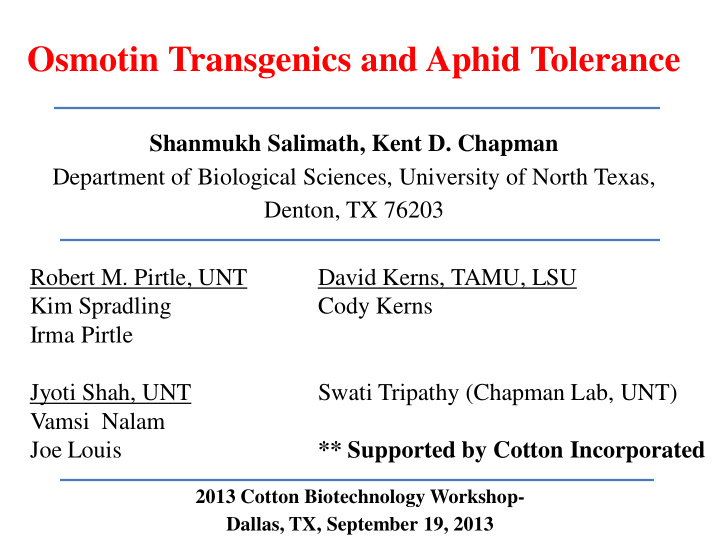



Osmotin Transgenics and Aphid Tolerance Shanmukh Salimath, Kent D. Chapman Department of Biological Sciences, University of North Texas, Denton, TX 76203 Robert M. Pirtle, UNT David Kerns, TAMU, LSU Kim Spradling Cody Kerns Irma Pirtle Jyoti Shah, UNT Swati Tripathy (Chapman Lab, UNT) Vamsi Nalam Joe Louis ** Supported by Cotton Incorporated 2013 Cotton Biotechnology Workshop- Dallas, TX, September 19, 2013
Osmotin (OSMII)- Background OSMII gene from cotton- Gene cluster 2 genes and 2 pseudogenes characterized by R. Pirtle Lab- 2005, 2006. small gene/no introns Promoter has ethylene-response elements— Experimentally induced by ethylene and ROS in cotton plants/ associated with defense responses Osmotin, member of the PR5 class of proteins- thaumatin superfamily N-terminal signal sequence- ER- exocytic pathway (vacuolar)
Osmotin (OSMII)- Objective Expression of apoplastic-directed tobacco OSM conferred tolerance to osmotic stress in cotton. Little impact on plant pathogen defenses (Parkhi et al, Mol Breeding (2009) 23:625–639). Objective here— In parallel, overexpress cotton OSMOTIN II ( GhOSMII ) in Arabidopsis thaliana and cotton ( G. hirsutum , Coker 312)- Test insect defense? “Pseudo-cisgenesis” approach in cotton, except 35S promoter.
Selected Cotton Transgenics Under Development Gene Construct /Plant Binary Vector used Quality/Agronomic Trait 1. AGP - Hydroxylase (from Alter fatty acid composition of cotton seed castor)/pBinCottonGlobRcOHOpt to produce hydroxy fatty acids 2. GhFAD2-4/pMDC32, pMDC43 Alter fatty acid composition of cotton seedlings and cold tolerance 3. 35S::GhOSMII – pMDC32 Produce elevated levels of defense gene related (antifungal, osmotic stress) proteins --- insect resistance 4. RNAi Suppression -2S Albumin Reduction of major seed storage protein, Seed-specific alcohol inducible the 2S albumin in cotton embryos cassette/pGREEN 5. 35S::AtFAAH/pCAMBIA1390 Fiber cell expansion and its influence on over all plant growth 6. Napin::HGGT - Hordeum vulgare (Hv) Elevation/accumulation of tocotrienols in homogentisate geranylgeranyl transferase cottonseeds (HGGT) /pKAN-NapinHvHGGT
Cotton Transgenics via Agrobacterium-mediated Transformation of Cotton Embryogenic Cell Lines Method In Brief- details in handout Preparation: Cotton cotyledon/leaf tissue culture @28 ⁰ C on MS+Maltose (MSM) media - produce callus – (1-2 months) Harvest Embryogenic Cells (ECLs) from Callus cultures – (2-3 months) Multiply ECLs in Liquid MSM for transformation – (3-5 months to this stage) Transformation: Co-culture ECLs with Agrobacterium containing gene construct of interest (48 hours) Develop embryos on MSM and selection medium (~2 months to this stage) Transfer transgenics to magenta boxes, acclimatize to soil, and seed production in greenhouse - (3-4 months to greenhouse from co-cultivation; 6-8 months to seed)
Callus Culture and Embryogenic Cells Lines Co- Cultivation with Cell Lines- Many, “Fresh” -- Numbers Game, Overcome problems somaclonal variation.
OSMII T0 transgenics: In Vitro Selection to Glasshouse
35S::GhOSMII Transgenic Plants in the Glasshouse
Osmotin Transgenics and Aphid Interactions Gossypium hirsutum - with David Kerns Lab, TAMU/ LSU Transgenic lines developed by Agrobacterium tumefaciens mediated • transformation of embryogenic cell lines Tested two transgenic-lines (2-OSMII and 4-OSMII) with cotton • aphid for antibiosis effects over 3 year period (growth chamber and field experiments)- T1- T4/T5 generations Arabidopsis thaliana - with Jyoti Shah Lab- UNT Transgenic lines developed by floral dip method (Clough and Bent, • 1998). Same construct as for cotton. Tested three transgenic lines with robust expression (RT-PCR/ • Western blot) for green peach aphid (GPA) antibiosis, antixenosis.
“No-choice” Cotton Aphid Feeding Experiments
PCR confirmed T1 transgenic plants of 2-OSMII and 4-OSMII lines and equal number of WT Coker 312 Transported to Dr. David Kerns at Texas Agri Life, Lubbock, for Cotton Aphid screening experiments in glass house Wild type and transgenic plants (n=8) with 2-4 true leaves were transplanted singly into enclosed cages (Figure X pic of cage) and placed in an environmental growth cabinet with a 14:10 L:D photoperiod and a temperature of 20 2 C. Five reproductively mature cotton aphids, Aphis gossypii , were placed on each plant. After 24 h, all of the adults were removed from the cages, and after 48 h, all but one nymph were removed from each cage. The remaining nymph was monitored daily and its progeny removed. From these data demographic data was produced as indicators for antibiotic resistance. Antibiosis was assessed by computing longevity (L), the natural rate of increase (r m ), generation time (T), finite daily increase (λ), and doubling time (DT) (Wyatt and White 1977, DeLoach 1974).
Gh. OSMII T4 and T5 seeds for field trial (2013) Seed Total Plant ID Generation Harvest date Seed # seeds 2-OSMII (plant#10) T5 10/22/2012 ~113 2-OSMII 2-OSMII (plant#17) T5 10/30/2012 ~153 T5 = ~266 2-OSMII (plant#16) T4 10/30/2012 ~233 2-OSMII 2-OSMII (plant#28) T4 10/30/2012 ~261 T4 = ~494 4-OSMII (plant#24) T5 10/22/2012 ~247 4-OSMII 4-OSMII (plant#23) T5 10/22/2012 ~152 T5 = ~399 4-OSMII (plant#2) T4 10/30/2012 ~231 4-OSMII 4-OSMII (plant#14) T4 09/24/2012 ~248 T4 = ~479
Field Trials • Genetically engineered cotton varieties and one Coker variety were planted in a RCB replicated 4 times with 4 row plots X 15 feet (2012), 2 rows X 20 feet (2013) • 10 Consecutive plants were tagged and monitored weekly for aphid populations beginning at detection of aphids by examining uppermost unfurled leaf of each plant. (2012 results were variable and inconclusive, plants went into field late in season, one event appeared to show some tolerance later in season, hurricane ended test early, - 2013 full trial- T4/T5 generations, two events)
Conclusions Transgenic (“psuedo-cisgenic”) events were generated in cotton (Coker 312) using an Agrobacterium-mediated transformation procedure with embryogenic cell lines. Experimental observations suggest that overexpression of OSMII confers significant tolerance to aphids, slowing their rate of reproduction (Arabidopsis and cotton, laboratory experiments) 2013 Field trials suggest positive effects by OSM transgene in reducing aphids, although effects were not significant early in season. Effects may take time to develop/appear. OSMII overexpression provides a novel strategy to help control phloem feeding insects in cotton plants- future—welcome collaborations to test stressors- fungal/bacterial pathogens or drought stress.
Recommend
More recommend